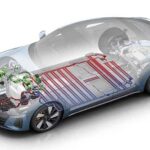Electric vehicle (EV) battery cooling is an important aspect of EV design and operation, as it affects battery life and performance. Here are some of the common EV battery cooling methods:

- Liquid Cooling
- Air Cooling
- Phase Change Material
- Thermoelectric Cooling
- Direct Expansion Cooling
Each of these methods has its own advantages and disadvantages, and the choice of cooling method will depend on the specific requirements of the EV design and application.
Exploring Liquid Cooling Methods
Liquid cooling is a widely used method for managing the temperature of electric vehicle (EV) batteries. This method involves circulating a liquid coolant through the battery pack to absorb heat and dissipate it through a radiator. Liquid cooling is effective in maintaining a consistent temperature and can help prolong battery life, improve performance, and reduce the risk of overheating.
There are several types of liquid cooling methods that can be used in EV batteries, including direct liquid cooling, indirect liquid cooling, and immersion cooling. Direct liquid cooling involves circulating the coolant directly through the battery cells, while indirect liquid cooling uses a heat exchanger to transfer heat from the battery pack to the coolant. Immersion cooling involves submerging the battery pack in a non-conductive coolant.
Air Cooling Methods for EV Battery
Air cooling is a simpler and less expensive method for managing the temperature of electric vehicle (EV) batteries compared to liquid cooling. This method involves using a fan or other cooling mechanism to circulate air over the battery pack to dissipate heat. Air cooling is effective in reducing the risk of overheating and can help maintain battery performance and longevity.
One advantage of air cooling is its simplicity, as it does not require a liquid coolant or complex cooling system. This can make it a more attractive option for smaller or less powerful EVs that do not require the level of cooling provided by liquid cooling methods. However, air cooling may not be as effective in maintaining a consistent temperature compared to liquid cooling, particularly in extreme weather conditions.
Overall, air cooling is a viable and cost-effective method for managing the temperature of EV batteries, particularly for smaller or less powerful EVs where the cooling demands are lower. However, more powerful EVs may require more advanced cooling methods to maintain optimal performance and longevity.
Phase Change Material (PCM) Cooling
PCM cooling systems can provide a number of advantages for EV battery cooling. For example, PCMs have high thermal energy storage density and can maintain a constant temperature by absorbing excess heat and storing it within the material until it reaches its melting point. At this point, the PCM releases the stored heat as it changes from a solid to a liquid state. This can help maintain a more stable temperature within the battery pack compared to traditional air or liquid cooling systems.
PCM cooling systems also have the potential to be lightweight, compact, and require less maintenance than other cooling methods, making them an attractive option for EV designers.
However, PCM cooling systems do have some limitations. They may not be as effective in cooling high-power or fast-charging EV batteries, and may require additional components such as heat exchangers to ensure efficient heat transfer.
Thermoelectric Cooling for Your EV Battery
Thermoelectric cooling is a method of cooling that uses a thermoelectric module (TEM) to manage the temperature of electric vehicle (EV) batteries. A TEM consists of two ceramic plates that are sandwiched around a semiconductor material. When an electric current is applied to the semiconductor, one side of the TEM becomes cooler while the other side becomes warmer, resulting in a temperature gradient.
Thermoelectric cooling has several advantages over traditional liquid or air cooling systems. For example, TEMs are lightweight, compact, and require no moving parts, making them more reliable and requiring less maintenance. They can also be used to cool specific areas of the battery pack, allowing for more precise temperature control.
Despite these limitations, thermoelectric cooling methods are a promising area of research and development in the EV industry. By optimizing TEM design and improving the efficiency of the cooling process, it may be possible to overcome some of the current limitations and create a more efficient and effective method of EV battery cooling.
Direct Expansion Cooling method
Direct Expansion (DX) cooling is a method of cooling electric vehicle (EV) batteries that uses a refrigerant to directly cool the battery cells. This method involves circulating the refrigerant through a loop that passes over the battery cells, absorbing heat and transferring it to a heat exchanger where it is dissipated.
DX cooling is a highly efficient method of battery cooling, as it provides direct contact between the refrigerant and the battery cells, allowing for rapid heat transfer. It can also be used to cool specific areas of the battery pack, allowing for more precise temperature control.
However, DX cooling systems can be complex and expensive, as they require additional components such as compressors and evaporators. They may also require regular maintenance and may be less reliable than simpler cooling methods such as air or liquid cooling.
Conclusion
Electric vehicle battery cooling is a critical aspect of ensuring optimal performance, safety, and longevity of the battery pack. Each of these methods has its advantages and limitations, and the choice of cooling method depends on factors such as the specific application, battery chemistry, and cost considerations.
Overall, the choice of EV battery cooling method depends on a range of factors, including performance requirements, cost considerations, and overall design goals. As the EV industry continues to evolve, new and innovative cooling methods are likely to emerge, providing improved performance, reliability, and efficiency for EV batteries.




